Sales planning is a fundamental component of sound selling. After all, you can‘t structure an effective sales effort if you don’t have, well, structure. Everyone — from the top to the bottom of a sales org — benefits from having solid, actionable, thoughtfully organized sales plans in place.
This kind of planning offers clarity and direction for your sales team — covering everything from the prospects you‘re trying to reach to the goals you’re trying to hit to the insight you're trying to deliver on.
But putting together one of these plans isn‘t always straightforward, so to help you out, I’ve compiled this detailed guide to sales planning — including expert-backed insight and examples — that will ensure your next sales plan is fundamentally sound and effective.

In this post, we'll cover:
Sales plans often include information about the business's target customers, revenue goals, team structure, and the strategies and resources necessary for achieving its targets.
What are the goals of an effective sales plan?
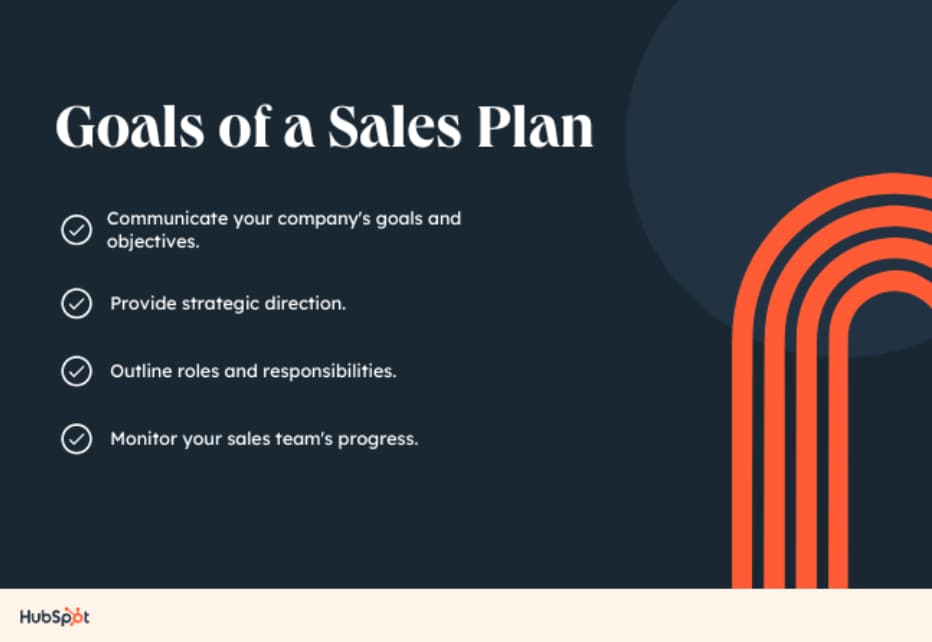
The purpose of your company's sales plan is to:
- Communicate your company's goals and objectives.
- Provide strategic direction.
- Outline roles and responsibilities.
- Monitor your sales team's progress.
Communicate your company's goals and objectives.
Goals and objectives are the lifeblood of successful sales efforts. You can‘t know what you’re working for or whether you‘ve achieved anything meaningful if you don’t have them in place.
Your sales reps need to have a solid sense of what‘s expected of them — you can’t go to your team and just say, "Sell." You have to establish clear benchmarks that reconcile practicality with ambition.
And if (or more likely when) those goals change over time, you need to regularly communicate those shifts and the strategic adjustments that come with them to your team.
Provide strategic direction.
Your sales strategy keeps your sales process productive — it offers the actionable steps your reps can take to deliver on your vision and realize the goals you set. So naturally, you need to communicate it effectively. A sales plan offers a solid resource for that.
For instance, your sales org might notice that your SDRs are posting lackluster cold call conversion rates. In turn, you might want to have them focus primarily on email outreach, or you could experiment with new sales messaging on calls.
Regardless of how you want to approach the situation, a thoughtfully structured sales plan will give both you and your reps a high-level perspective that would inform more cohesive, effective efforts across the team.
Outline roles and responsibilities.
An effective sales org is a machine — one where each part has a specific function that serves a specific purpose that needs to be executed in a specific fashion. That's why everyone who comprises that org needs to have a clear understanding of how they specifically play into the company's broader sales strategy.
Outlining roles and responsibilities while sales planning lends itself to more efficient task delegation, improved collaboration, overlap reduction, and increased accountability. All of which amount to more streamlined, smooth, successful sales efforts.
Monitor your sales team's progress.
Sales planning can set the framework for gauging how well your team is delivering on your sales strategy. It can inform the benchmarks and milestones reps can use to see how their performance stacks up against your goals and expectations.
It also gives sales leadership a holistic view of how well a sales org is functioning as a whole — giving them the necessary perspective to understand whether they have the right people and tools in place to be as successful as possible.
Sales Planning Process
Sales planning isn‘t (and shouldn’t) be limited to the actual sales plan document it produces. If that document is going to have any substance or practical value, it needs to be the byproduct of a thorough, well-informed, high-level strategy.
When sales planning, you have some key steps you need to cover — including:
- Gather sales data and search for trends.
- Define your objectives.
- Determine metrics for success.
- Assess the current situation.
- Start sales forecasting.
- Identify gaps.
- Ideate new initiatives.
- Involve stakeholders.
- Outline action items.
When putting this list together, I consulted Zach Drollinger — Senior Director of Sales at edtech provider Coursedog — to ensure the examples detailed below are sound and accurate.
Step 1: Gather sales data and search for trends.
To plan for the present and future, your company needs to look to the past. What did sales look like during the previous year? What about the last five years? Using this information can help you identify trends in your industry. While it's not foolproof, it helps establish a foundation for your sales planning process.
Example
For the sake of example, let‘s say that I’m a new sales director for an edtech company that sells curriculum planning software to higher education institutions. My vertical is community colleges, and my territory is the East Coast.
Once I assume this new role, I‘m going to want to gather as much context as possible about my vertical and how my company has approached it historically. I would pull information about how we’ve sold to this vertical.
How much new business have we closed within it in the past five years? How does that compare to how we perform with other kinds of institutions? Are we seeing significant churn from these customers?
I would also want to get context about the general needs, interests, and pain points of the kinds of institutions I‘m selling to. I’d look for insight into figures like degree velocity, staff retention, and enrollment.
Ultimately, I would get a comprehensive perspective on my sales process — a thorough understanding of where I stand and what my prospects are dealing with. That will ensure that I can deliver on the next step as effectively as possible.
Step 2: Define your objectives.
How do you know your business is doing well if you have no goals? As you can tell from its placement on this list, defining your goals and objectives is one of the first steps you should take in your sales planning process. Once you have them defined, you can move forward with executing them.
Example
To extend the example from the previous step, I would leverage the context I gathered through the research I conducted about both my and my prospect's circumstances. I would start setting both broader goals and more granular operational objectives.
For instance, I might want to set a goal of increasing sales revenue from my vertical. From there, I would start putting together the kind of specific objectives that will facilitate that process — like connecting with administrators from at least 30 community colleges, booking demos with at least 10 schools, and successfully closing at least five institutions.
Obviously, those steps represent a streamlined (and unrealistically straightforward) sales process, but you get the idea — I would set a concrete goal, supplemented by SMART objectives, that will serve as a solid reference point for my org's efforts as the sales process progresses.
Step 3: Determine metrics for success.
Every business is different. One thing we can all agree on is that you need metrics for success. These metrics are key performance indicators (KPIs). What are you going to use to determine if your business is successful? KPIs differ based on your medium, but standard metrics are gross profit margins, return on investment (ROI), daily web traffic users, conversion rate, and more.
Example
I kind of covered this step in the previous example, but it still warrants a bit more elaboration. The “M” in SMART goals (“measurable”) is there for a reason. You can‘t tell if your efforts were successful if you don’t know what “successful” actually means.
The edtech sales example I‘ve been running with revolves mostly around me assuming ownership of an existing vertical and getting more out of it. So it’s fair to assume that sales growth rate — the increase or decrease of sales revenue in a given period, typically expressed as a percentage — would be an effective way to gauge success.
I might want to structure my goals and objectives around a sales growth rate of 20% Y/Y within my vertical. I would make sure my org was familiar with that figure and offer some context about what it would take to reach it — namely, how many institutions we would need to close and retain.
Step 4: Assess the current situation.
How is your business fairing right now? This information is relevant to determining how your current situation holds up to the goals and objectives you set during step two. What are your roadblocks? What are your strengths? Create a list of the obstacles hindering your success. Identify the assets you can use as an advantage. These factors will guide you as you build your sales plan.
Example
Continuing the edtech example, I would use the historical context I gathered and the objectives I set to frame how I look at my current circumstances. I might start by considering my goal of increasing revenue by 20% Y/Y. In that case, I would look at the company's retention figures — ideally, that would give me a sense of whether that needs to be a major area of focus.
I would also try to pin down trends in the colleges that we've already closed — are there any pain points we consistently sell on? I might take a closer look at how we demo to see if we might be glossing over key elements of our value proposition. Maybe, I would use conversation intelligence to get a better sense of how reps are handling their calls.
Ultimately, I would try to identify why we're performing the way we are, the inefficiencies that might be resulting from our current strategy, and how we can best set ourselves up to sell as effectively as possible.
Step 5: Start sales forecasting.
Sales forecasting is an in-depth report that predicts what a salesperson, team, or company will sell weekly, monthly, quarterly, or annually. While it is finicky, it can help your company make better decisions when hiring, budgeting, prospecting, and setting goals.
After the COVID-19 pandemic, economics has become less predictable. Claire Fenton, the owner of StrActGro — a professional training and coaching company — states, “Many economic forecasters won't predict beyond three months at a time.” This makes sales forecasting difficult. However, there are tools at your disposal to create accurate sales forecasts.
Example
In our edtech example, I would approach this step by trying to estimate how my sales org is going to fare with the specific vertical we‘re pursuing in the time window we’ve allotted.
The method I decide to go with will depend on factors like how many concrete opportunities we have lined up — in addition to elements like the kind of historical data we have handy, how the reps working these deals tend to perform, and the degree of insight we have about our potential customers.
Let's say I consider those factors and decide to run something called a multivariable analysis. In that case, I could start by taking stock of the opportunities my reps have lined up. Then, I could look at the reps working those deals, their typical win rates, and the time they have to close — among other factors.
For instance, I might calculate that a rep working with a particularly large institution has a 50% chance of closing within the window we‘ve allotted. Using that insight, we could attribute 50% of the potential deal size to our forecast — we’d repeat that process with all of the opportunities in question and ideally get a solid sense of the revenue we can expect to generate in this window.
Step 6: Identify gaps.
When identifying gaps in your business, consider what your company needs now and what you might need in the future. First, identify the skills you feel your employees need to reach your goal. Second, evaluate the skills of your current employees. Once you have this information, you can train employees or hire new ones to fill the gaps.
Example
Continuing the edtech example, let‘s say my forecast turned up results that weren’t in keeping with what we need to reach our goals. If that were the case, I would take a holistic look at our process, operations, and resources to pin down inefficiencies or areas for improvement.
In my search, I find that our sales content and marketing collateral are dated — with case studies that don‘t cover our product’s newest and most relevant features. I also might see that our reps don‘t seem to have too much trouble booking demos, but the demos themselves aren’t converting due to a lack of training and inconsistent messaging.
And finally, I find that a lack of alignment with marketing has prospects focusing on unrealistic outcomes our sales team can‘t deliver on. Once I’ve identified those gaps, I would start to hone in on ways to remedy those issues and improve those elements.
Step 7: Ideate new initiatives.
Many industry trends are cyclical. They phase in and out of “style.” As you build your sales plan, ideate new initiatives based on opportunities you may have passed on in previous years.
If your business exclusively focused on word-of-mouth and social media marketing in the past, consider adding webinars or special promotions to your plan.
Example
In the edtech example we've been running with, I would likely ideate initiatives based on the gaps I identified in the previous step. I would start a push to ensure that our sales content and marketing collateral are up-to-date and impressive.
I would also consider new training programs to ensure that our coaching infrastructure is prioritizing how to conduct effective demos. Finally, I would start to work on a plan with marketing to ensure our messaging is aligned with theirs — so we can make sure prospects' expectations are realistic and effective.
One way or another, I would take the gaps I found and find concrete, actionable ways to fill them. I would make sure that these initiatives aren't abstract. Just saying, "We're going to be better at demos," isn‘t a plan — it’s a sentiment, and sentiments don't translate to hard sales.
Step 8: Involve stakeholders.
Stakeholders are individuals, groups, or organizations with a vested interest in your company. They are typically investors, employees, or customers and often have deciding power in your business. Towards the end of your sales planning process, involve stakeholders from departments that affect your outcomes, such as marketing and product. It leads to an efficient and actionable sales planning process.
Example
This step is sort of an extension of the previous two — once I‘ve identified the key issues and roadblocks obstructing my edtech startup’s sales org, I would start identifying the right people to fulfill the necessary initiatives I've put together.
In this example, I would tap some stakeholders in charge of our sales content and marketing collateral to produce newer, more relevant case studies and whitepapers we can pass along to the institutions we're working with.
I would also go to middle management and either offer more direction for coaching on demos or bring in a third-party training service to offer more focused, professional insight on the issue.
Finally, I would connect with marketing leadership to align on the benefits and outcomes we generally stress when pitching the schools we sell to. That way, we can ensure that the institutions we're connecting with have realistic expectations of our product or service that we can speak to more clearly and effectively.
Step 9: Outline action items.
Once you have implemented this strategy to create your sales planning process, the final step is outlining your action items. Using your company's capacity and quota numbers, build a list of steps that take you through the sales process. Examples of action items are writing a sales call script, identifying industry competitors, or strategizing new incentives or perks.
Example
In our edtech example, some key action items might be:
- Revamp our prospecting strategy via more involved coaching and re-tooled sales messaging.
- Revamp administrator and college dean buyer personas.
- Conduct new trainings on demoing our software.
- See our new prospecting strategy from ideation to execution.
- Align with our sales enablement stakeholders for new, more relevant case studies and whitepapers.
Obviously, that list isn‘t exhaustive — but those are still the kinds of steps we would need to clarify and take to structure a more effective high-level strategy to produce different (ideally much better) results than we’ve been seeing.
One thing to keep in mind is that sales planning shouldn't end with creating the document.
You‘ll want to reiterate this process every year to maintain your organization's sales excellence.
Now that you‘re committed to the sales planning process, let's dive into the written execution component of sales planning.

Ready to write your own plan? Download HubSpot's Free Sales Plan Template to get started.
What Goes in a Sales Plan Template?
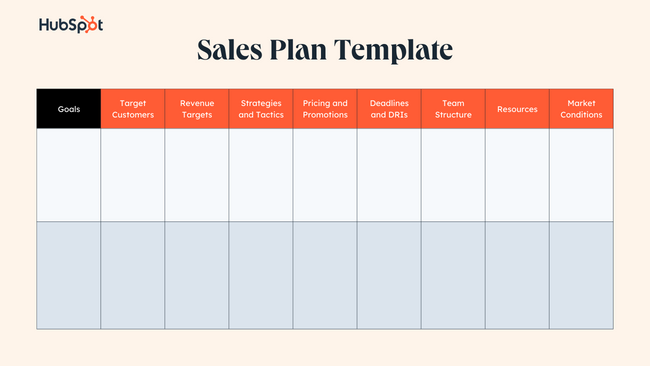
A typical sales plan includes the following sections:
- Target Customers
- Revenue Targets
- Strategies and Tactics
- Pricing and Promotions
- Deadlines and DRIs
- Team Structure
- Resources
- Market Conditions
Once again, I consulted Zach Drollinger — Senior Director of Sales at edtech provider Coursedog — to ensure the examples detailed below are sound and accurate.
Target Customers
Your target customers are who your company aims to serve with its products and services. They're the individuals most likely to buy your products. Target customers are created by dividing your target market into smaller, more focused groups through divisions based on geography, behavior, demography, and more.
You also need to have a pulse on the kinds of contacts you‘re going to be dealing with, along with each one’s degree of decision-making authority. The personas you target are going to have varying pain points, interests, and preferences — you need to be able to speak to all of those unique elements when you‘re dealing with different stakeholders at the companies you’re selling to.
Example
To continue with our edtech example, we established that my territory is the East Coast, and my vertical is community colleges — so from a high level, my target market is exactly that: community colleges on the East Coast.
That much is straightforward, but my target customers aren‘t limited to the institutions I’m selling to. I need to understand the points of contact I‘m going to be dealing with when I’m selling to these colleges.
Modern buying decisions generally require input from multiple stakeholders — especially with an organization as large as a community college. In this case, my understanding of my target customers will need to be a bit more granular than just “representatives from the school.”
I would most likely be dealing with administrators and deans when trying to sell curriculum scheduling software — two personas with unique slates of responsibilities. In that case, I would need to establish a solid understanding of both kinds of customers when sales planning.
I‘d have to consider factors like what their day-to-days look like, the pain points that stem from the tasks they’re generally expected to fulfill, how my software could play into those, and why their lives would become easier as a result of buying.
Revenue Targets
Target revenue is how much money your company aims to bring in during a given time. You can measure revenue targets by determining a growth percentage to add to the previous year, estimating revenue based on employee capacity, or summing up the sales quota from your team.
Example
Continuing with our edtech example, I would pull directly from the SMART goals we've set to cover this base. I would look at the revenue figure we need to hit to cover the 20% revenue increase figure we established as our ideal outcome earlier.
Strategies and Tactics
Strategies and tactics are specific actions your team will take to reach revenue targets. You might consider using social media to generate leads. Your company could also turn to associates to ask for referrals. Instead of focusing all your efforts on new clients, a sales strategy could be keeping up with past clients or customers. These are avenues to explore when building a sales plan.
Example
Running with our edtech example, I would consider my org‘s goals and allocation of responsibilities to put this together. I might start by calling out my org’s intention to leverage conversation intelligence to inform better coaching for SDRs on calls and more effective sales messaging.
I could also mention that the org might focus on enabling our account management team to ensure that we retain the customers we currently have. And finally, I could mention that we‘re going to revamp our demo process to emphasize certain features that we’re finding are more popular and impressive than others.
Pricing and Promotions
Pricing and promotions typically hold the most interest for customers. It documents your offering's price and any upcoming promotions for converting customers.
A free trial is a popular promotional tactic that companies like Amazon and Hulu use to entice customers to buy in once the free session is over. Be mindful and intentional with your pricing and promotions. Your company must find the middle ground between making a profit and looking appealing to your target customers.
Example
In the edtech example, the sales org would take a holistic look at our pricing model to ensure that our pricing reflects our ideal market position and a realistic ability to generate the kind of revenue we need.
I — along with other sales leaders at the company — would evaluate where our prices fall in the context of our competitive landscape. We would see if our price was too outlandish to be a rational choice for the institutions we appeal to or too much of a bargain that it undermines our perceived quality.
Hopefully, our understanding of our target market — coupled with the quality of our product will — will allow us to sell at a price point that can register with enough institutions to let us hit the revenue targets we've established.
Deadlines and DRIs
Deadlines and Directly Responsible Individuals (DRIs) outline any critical dates for deliverables and list who is accountable for their completion. There are many moving parts to a business. Creating a timeline and assigning responsibility to each task is necessary to keep your sales org running successfully.
Example
In our edtech example, some DRIs might include:
-
Director of Sales Development, who will ensure that our prospecting strategy is as productive as possible.
-
Account Executives, who will be demoing the software and closing deals with the institutions.
-
Account Managers, who will be responsible for ensuring our existing accounts stay on board.
Team Structure
Your team structure often depends on the size of your company. Smaller businesses tend to have a small team, and that can potentially exacerbate issues with overlap and confusion. As your company grows, you will need to hire new employees. The more employees you have, the harder it can be to manage these different members. Your sales plan needs to outline the members of your team and what their specific role is to provide clarity.
Example
Here's a cursory overview of what a team structure might look like in the context of our edtech example:
-
Joan — Director of Sales Development — will ensure that our prospecting strategy is as productive as possible.
-
Bobby and Sally — Account Executives — will be demoing the software and closing deals with the institutions.
-
Roger and Peggy — Account Managers — will be responsible for ensuring our existing accounts stay on board.
-
Don, Trudy, Bert, and Betty — Sales Development Representatives — will connect with institutions to book demos.
Resources
The people on your team are the most influential tool for implementing your sales plan, but to do so, they need resources. These are the tools your team will use to reach revenue targets. Your company could use project management resources like Monday or Asana to keep track of deadlines. Programs like Adobe Photoshop and Canva are resources for designing graphics to send to prospects. While your team is essential, their function becomes obsolete without the tools to do their job.
Example
In our edtech example, I might take stock of the org‘s resources and find we’re leveraging:
-
A CRM to provide a centralized repository of our prospect and customer data.
-
Conversation intelligence software to guide better-structured, more effective coaching for our sales calls.
-
Sales enablement software to centralize and manage our sales enablement resources.
-
Additional budget that could be allocated for a spiff to motivate SDRs to book more demos.
-
Case studies that speak to how other community colleges have successfully leveraged our software.
-
Any other resources we might have available that can be used to educate buyers or enhance our sales professionals' efforts.
Market Conditions
Market conditions are pertinent information about your industry and its competitive landscape. What's trending? Where are customers losing interest? Have there been any competitors gaining traction in the industry, and why? The way your market is fairing should guide how you approach your sales plan.
Now let‘s walk through how to write a sales plan. Don't forget to follow along with HubSpot's free Sales Plan Template to make the most of this blog post.
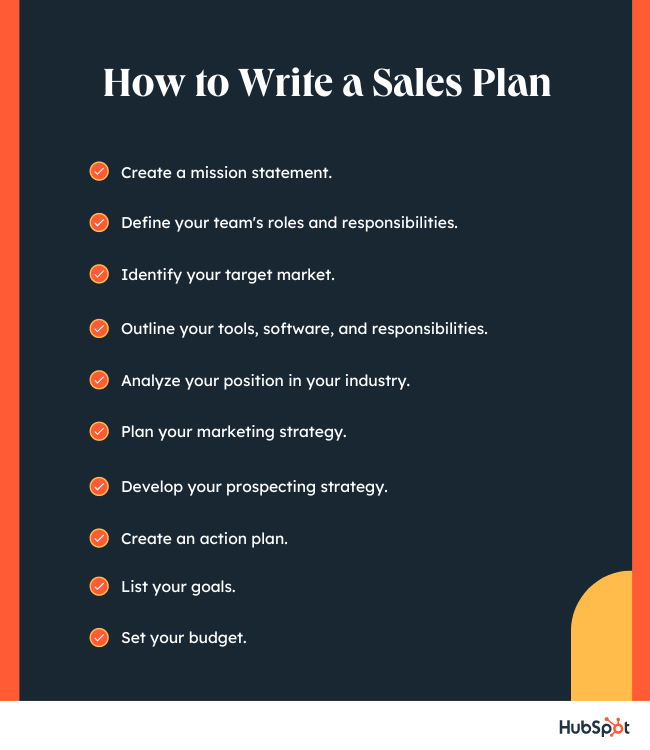
As I did with the previous sections, I consulted Zach Drollinger — Senior Director of Sales at edtech provider Coursedog — to ensure the examples detailed below are sound and accurate.
1. Create a mission statement.
Start your sales plan with a mission statement — a concise, straightforward distillation of what your business hopes to accomplish from a fundamental, more idealistic perspective. You don't want to get too hung up on detailing the “how” behind your business here.
Offer your vision — not your “About Us” page.
Example
In our edtech example, the company's mission statement might say something like, “Our mission is all about empowerment. We empower higher education institutions to empower their students — maximizing schools' abilities to help their students realize their full potential by facilitating timely graduation and simple, seamless class scheduling.”
2. Define your team's roles and responsibilities.
Next, describe who is on your team and what their roles are. Perhaps you manage five salespeople and work closely with a sales enablement professional and a sales ops specialist. If you‘re planning on adding headcount, include the number of employees, their job titles, and when you're planning to bring them on the team.
Example
I touched on this in the previous section, but to reiterate, here's what part of this section would look like in the context of our edtech example:
-
Joan — Director of Sales Development — will ensure that our prospecting strategy is as productive as possible.
-
Bobby and Sally — Account Executives — will be demoing the software and closing deals with the institutions.
-
Roger and Peggy — Account Managers — will be responsible for ensuring our existing accounts stay on board.
-
Don, Trudy, Bert, and Betty — Sales Development Representatives — will connect with institutions to book demos.
3. Identify your target market.
Whether you're writing your first sales plan or your 15th, knowing your target demographic is crucial. What do your best customers look like? Do they all belong to a specific industry? Exceed a certain size? Struggle with the same challenge?
Keep in mind you might have different buyer personas for different products. For example, HubSpot's salespeople might primarily sell marketing software to CMOs and sales software to sales directors.
This section of your sales plan can also change dramatically over time as your solution and strategy evolve and you adjust product-market fit. In the very beginning, when your product was in its infancy, and your prices were low, you may have found success selling to startups. Now that the product is far more robust and you‘ve raised the price, mid-market companies are likely a better fit. That‘s why it’s important to review and update your personas consistently.
Example
Again, I covered this one in the previous section — but for the sake of you not having to scroll back up, I'll say it again:
To continue with our edtech example, we established that my territory is the East Coast, and my vertical is community colleges — so from a high level, my target market is exactly that: community colleges on the East Coast.
That much is straightforward, but my target customers aren‘t limited to the institutions I’m selling to. I need to understand the points of contact I‘m going to be dealing with when I’m selling to these colleges.
Modern buying decisions generally require input from multiple stakeholders — especially with an organization as large as a community college. In this case, my understanding of my target customers will need to be a bit more granular than just “representatives from the school.”
I would most likely be dealing with administrators and deans when trying to sell curriculum scheduling software — two personas with unique slates of responsibilities. In that case, I would need to establish a solid understanding of both kinds of customers when sales planning.
I‘d have to consider factors like what their day-to-days look like, the pain points that stem from the tasks they’re generally expected to fulfill, how my software could play into those, and why their lives would become easier as a result of buying.
4. Outline your tools, software, and resources.
You should also include a description of your resources — and that's not necessarily limited to the software you might be leveraging. You should detail key tools like the CRM you‘re using, but don’t ignore resources like budget you might have for a sales contest. You should also address resources like training, documentation, and sales collateral.
Example
Once again, in our edtech example, I might take stock of the org‘s resources and find we’re leveraging:
-
A CRM to provide a centralized repository of our prospect and customer data.
-
Conversation intelligence software to guide better-structured, more effective coaching for our sales calls.
-
Sales enablement software to centralize and manage our sales enablement resources.
-
Additional budget that could be allocated for a spiff to motivate SDRs to book more demos.
-
Case studies that speak to how other community colleges have successfully leveraged our software.
-
Any other resources we might have available that can be used to educate buyers or enhance our sales professionals' efforts.
5. Analyze your position in your industry.
Now, name your competitors. Explain how your products compare, where theirs are stronger than yours, and vice versa. In addition, discuss their pricing versus yours. You should also discuss market trends. If you're a SaaS company, you should note what vertical-specific software is becoming more popular. If you sell ads, mention the rise in programmatic mobile advertising. Try to predict how these changes will influence your business.
Example
In our edtech example, I would take a thorough look at the types of institutions that typically buy from us. What do their enrollment figures look like? If we had a tiered pricing structure, what price point do they typically buy at? What's the ballpark of their typical budgets? And perhaps most importantly, what are the pain points that generally drive them to explore our solution?
Once I had a picture of those elements, I would look at the rest of our competitive landscape — and ideally, I would be able to cover those same bases for our competitors and their buyers.
By pinning down those elements — among several others — I would get a sense of what kind of buyers gravitate to each solution in our market. It would cue me into how prospects typically perceive our offering, showing us who we are in our competitive landscape.
Having that sense will give my team an understanding of where they're selling from, what kinds of institutions are going to be most receptive to our efforts, and how to best approach every engagement we pursue.
6. Plan your marketing strategy.
In this section, describe your pricing and any promotions you're planning on running. What key actions will you take to increase brand awareness and generate leads? Note the impact on sales.
Here's a mock version:
- Product A: Increasing price from $40 to $45 on Feb. 2 (2% reduction in monthly sales)
- Product B: Free upgrade if you refer another customer from Jan. 1-20 (20% increase in monthly sales)
- Product C: Decreasing price from $430 to $400 on March 1 (15% increase in monthly sales)
- Product D: No change
Example
For our edtech example, let's say we intend to lean heavily on an inbound marketing strategy. In that case, leadership at the company would want to invest in a company blog that covers trends and concepts in the education industry. Ideally, that resource will produce a steady stream of leads while simultaneously establishing our business as a trusted authority in the space.
7. Develop your prospecting strategy.
How will your sales team receive and qualify the leads generated by your marketing strategy? Don't forget to include the criteria prospects should meet before sales reps reach out.
Example
Let‘s say that our hypothetical edtech company’s inbound marketing infrastructure development pans out. We're able to maintain a reputable blog about the education industry that brings in a steady stream of leads. That could provide the basis for an effective prospecting strategy.
Our content marketing department could produce and qualify warm leads to pass to our sales team. Ideally, we'll have more effective, focused criteria to determine whether and how to reach out to those leads. From there, we might elect to focus primarily on email outreach — a plan that could be complemented by a more conventional cold-calling strategy.
8. Create an action plan.
Once you‘ve outlined where you want to go, you must figure out how you'll get there. This section summarizes your game plan for hitting your revenue targets. Try to be thorough but concise when detailing these steps — and try to support any items you detail with a clear, viable timeline.
Example
Here's what part of the action plan might look at our hypothetical edtech company:
Objective: Increase revenue in our East Coast community college vertical by 20% Y/Y.
- Revamp our prospecting strategy via more involved coaching and re-tooled sales messaging (Timeline: Q1)
- Leverage conversation intelligence to shadow calls — offering more perspective on effective elements of current strategies and areas for improvement.
- Revamp administrator and college dean buyer personas (Timeline: Q1)
- Reference historical data in CRM for trends in successful and unsuccessful sales engagements with these kinds of contacts.
- Implement a new training framework for demos. (Timeline: Q1)
- Conduct email outreach to inbound leads (Timeline: Q1-Q4)
We would flesh this plan out to cover the key actions that are going to shape our high-level strategy and guide the more granular aspects of its implementation. Committing plans to writing is crucial in sales — including action items in your sales plan gives you a definitive forum for that.
9. List your goals.
Most sales goals are revenue-based. For example, you might set a total target of $10 million in annual recurring revenue (ARR). Alternatively, you can set a volume goal. That could be 100 new customers or 450 sales. Make sure your objective is realistic; otherwise, your entire sales plan will be largely useless.
Factor in your product's price, total addressable market (TAM), market penetration, and resources (including your sales headcount and marketing support).
Your goal should also be closely tied to your high-level business goals. For example, suppose the company is trying to move upmarket. In that case, your goal might be “Acquire 20 Enterprise logos” rather than “Sell X in new business” (because the latter will encourage you to solely chase deals rather than focus on the right type of customers).
Of course, you'll probably have more than one goal. Identify the most important, then rank the rest by priority. If you have territories, assign a sub-goal to each. That will make it easier to identify over- and under-performers.
Lay out your timeline too. Having regular benchmarks lets you know if you‘re on track, ahead, or behind in meeting your targets. Suppose your sales goal for the first quarter of the year is selling $30,000. Based on last year’s performance, you know January and February sales are slower than March.
With that in mind, your timeline is:
- January: $8,000
- February: $8,000
- March: $14,000
You should also write in the DRIs if applicable. For example, maybe Rep Carol‘s January quota is $5,000. Rep Shane, who‘s still ramping, has a $3,000 monthly quota. On a smaller team, this exercise helps people avoid replicating each other‘s work and shifting blame around if targets aren’t met.
10. Set your budget.
Describe the costs associated with hitting your sales goals. That usually includes:
- Pay (salary and commission)
- Sales training
- Sales tools and resources
- Contest prizes
- Team bonding activities
- Travel costs
- Food
Compare the sales plan budget to your sales forecast for accurate budgeting.
If you want to take your plan to the next level, read on to learn some tips for creating a highly effective sales plan.
Tips for Creating an Effective Sales Plan
We've gone over what you should include in a sales plan, including some examples and mockups.
Learn some tips and tricks for creating a sales plan that helps you hit target numbers and exceed your higher-ups' expectations.
- Use industry trends to strengthen your plan. When presenting your sales plan to a stakeholder, use industry trends to highlight why your plan will be effective.
- Specify the technology you‘ll use to track success. You can do this for internal reference or let stakeholders know how you'll measure success. Some tools you can consider include CRM and dashboard software.
- Support your budget proposal with hard facts and data. If you're creating a budget as a part of your plan, support it with previous performance data and sales forecasts.
- Create different plans for each team. If you create a sales plan for business development, inbound sales, outbound sales, field sales, and so forth, you can get even more granular and specific in your goals and KPIs.
- Get marketing's input. Marketing and sales alignment is critical for the success of your sales plan. The more input you have from marketing, the more you can align your lead generation, prospecting, and nurturing efforts.
- Talk with your sales reps to understand their challenges. It might be easy to get lost in numbers and forecasts — but it‘s important to know your sales representatives' day-to-days to understand what will and will not prove effective or feasible.
- Complete an in-depth competitive analysis. You must know what the competition is doing well to create a plan that nudges your company in that direction.
Sales Plan Examples
You can create a few different types of sales plans for your organization. Here are some examples.
30-60-90-Day Sales Plan
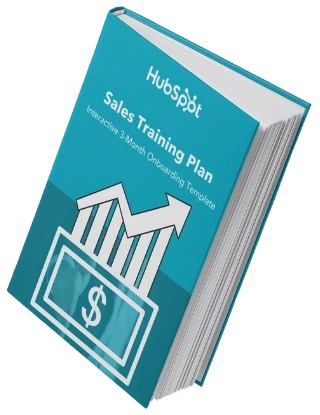
Download Now: Free Sales Training Template
This general sales plan is defined not by theme but by time frame. You'll create three goals: one for the 30-day mark, another for the 60-day mark, and the last for the 90-day mark. You can choose to focus on quotas or reduce customer churn by a certain percentage.
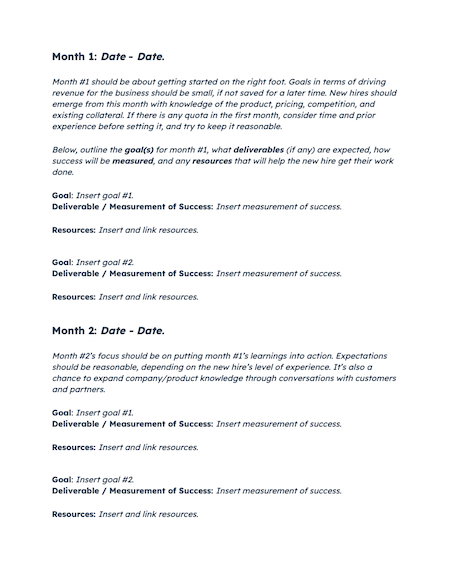
Consider this plan if you're new to the role since you can use it to track your progress during your first 90 days. A 30-60-90 day plan can also be useful for a new business that's still figuring out its sales goals.
Peggy Ratcliff McKee, an executive career coach at Career Confidential, describes the 90-day plan as “a great starting point… [where] you may end up speeding up your goals or extending them depending on the specific needs of your new company.”
Marketing-Alignment Sales Plan
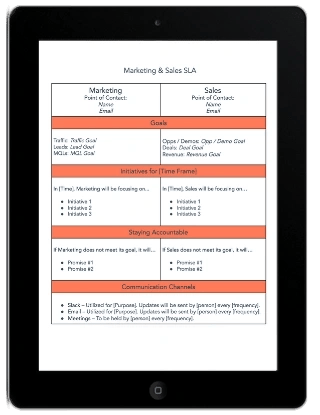
Download Now: Free Marketing & Sales Alignment Template
In many ways, a traditional sales plan is already aligned with marketing. Still, you can create a marketing-alignment sales plan if your organization has not yet aligned both of these departments.
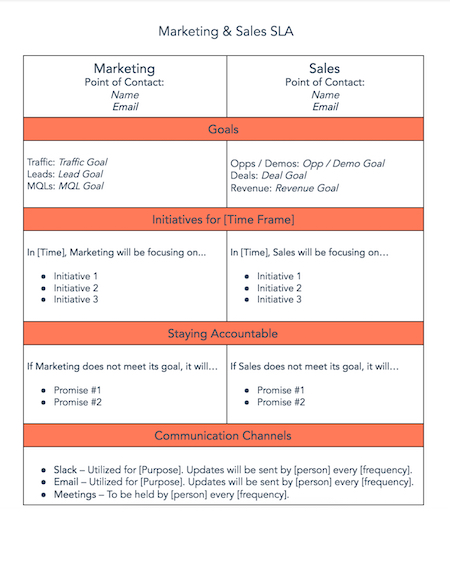
The plan's focus will be on establishing ideal customer profiles and buyer personas and aligning marketing‘s messaging with sales' product pitch. A strong marketing-sales alignment ensures everyone within your organization is on the same page and reduces miscommunication down the line.
Business Development Strategic Sales Plan
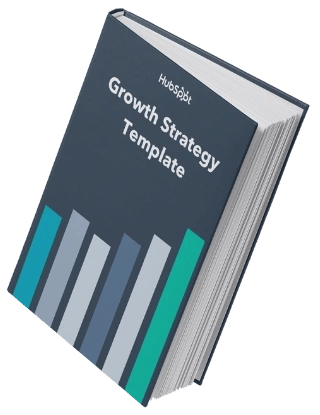
Download Now: Free Strategic Business Planning Template
A strategic sales plan for business development will focus on attracting new business to your company by networking with other companies, sponsoring events, and doing outreach. In your sales plan, you'll want to choose the right KPIs that best reflect performance for these specific outreach channels.
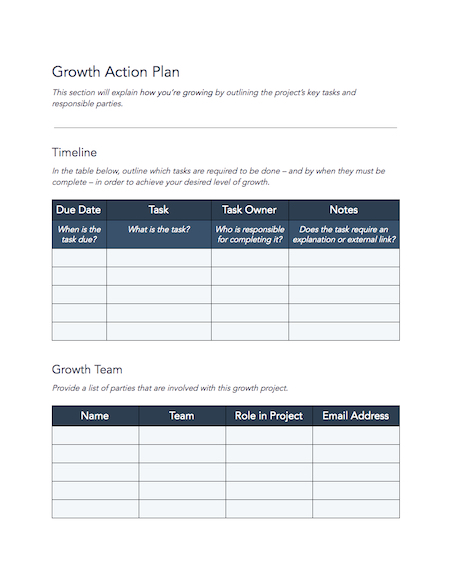
Business development is imperative for long-term success because it will help your organization better understand your industry's competitive landscape and strategize on how to stand out. Plus, it ensures that everyone at your company is working toward a common goal.
Market Expansion Plan
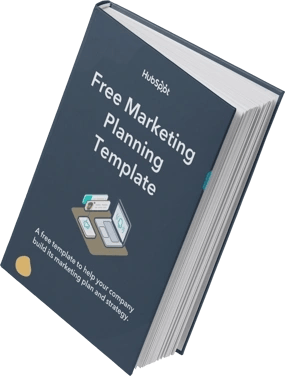
Download Now: Free Marketing Plan Template
A market expansion plan outlines a task list and target metrics when expanding into a new market or territory. This type of sales plan is specifically concerned with addressing a target market in a new geographical area.
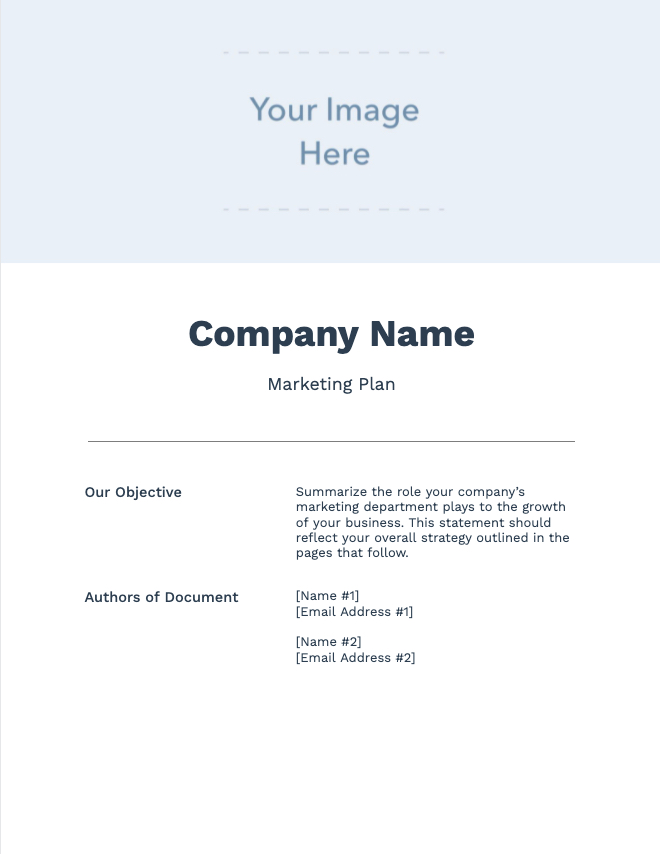
You'll typically take into account distribution costs and, if applicable, time zone differences between your sales representatives and target buyers, as well as other logistical factors.
New Product Sales Plan

Download Now: Free Product Launch Kit
If you're launching a new product, create a sales plan specifically to generate revenue from the new launch.
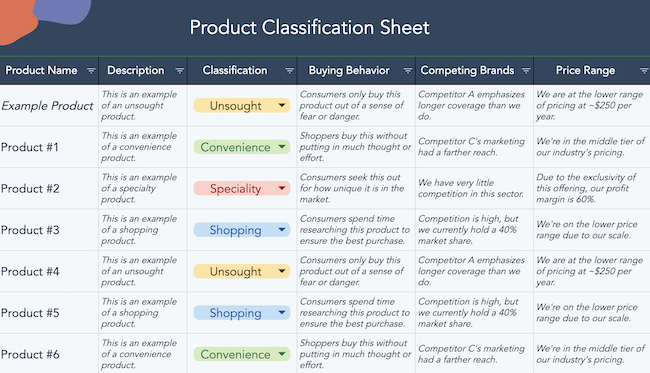
It‘ll be crucial to carry out competitive analysis, determine a sales strategy, strengthen your brand positioning, and secure channel partners if you're shifting to a channel sales model.
Strategic Sales Plan Examples
If you need some more inspiration, take a look at these sales plan examples.

![]()
We've created a sales plan template that outlines the key elements of a sales plan. This template will walk you through each of the steps to write a sales plan of your own.
Our plan allows you to easily communicate to your organization what your goals are, how you'll accomplish them, and what support you need.

Image Source
Organizing your strategies and goals with a sales plan will make it easier for you and your sales team to stick to the targets you've set. This template is nine pages long and provides plenty of opportunities to create a concrete action plan.
We like it because it includes a goals section before breaking it down into more specific areas such as demand generation, implementation, and measurement and evaluation. This
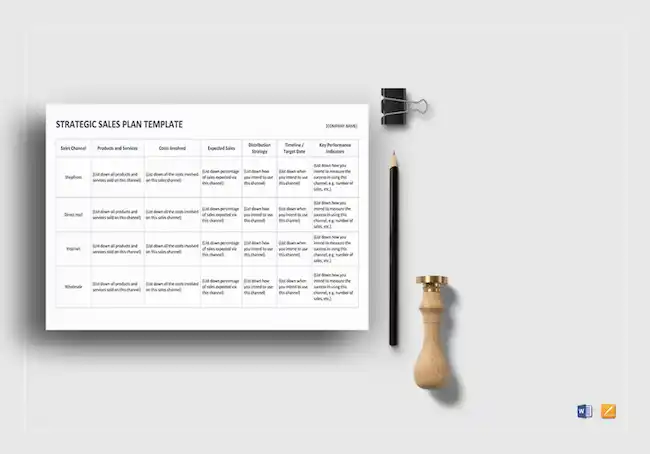
Image Source
A sales plan doesn't need to be hundreds of pages long. Try consolidating your sales plan into a page or two. This template is an excellent example of making it short and sweet while still communicating the most important elements of the plan.
In landscape mode, this strategic sales plan includes a channel, expected costs and sales, distribution strategy, and key performance indicators in an easy-to-read grid layout.
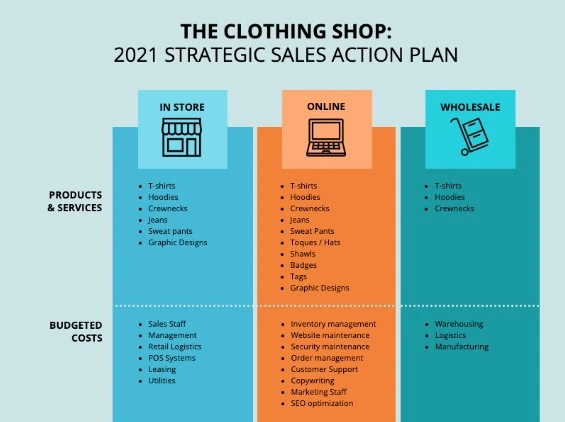
Image Source
Choose a design that fits your needs and create your sales plan using Venngage‘s interface which includes custom charts, stock photos, and illustrations. You'll have several visually interesting options, all available in just a single tool.
We like this plan because it‘s organized by type of sale: in-store, online, and wholesale. This makes it easier to identify each sales channel's needs and which departments contribute to their success.
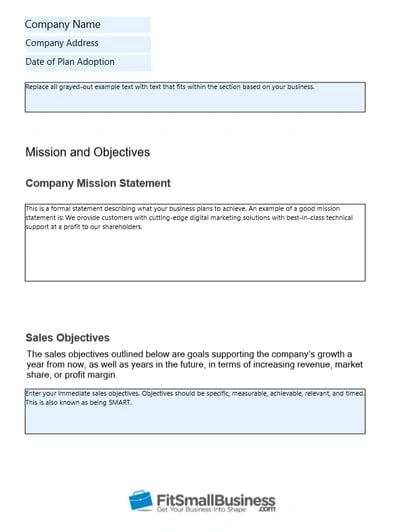
Image Source
If you run a small business, you may not yet have a fully stacked sales team. You and your employees likely wear many hats, so it's important to establish a strong sales strategy for your company that future hires can build off of.
Sometimes simpler is better, so this plan relies on several standard sections to draw up your plan, with boxes that can be easily filled out using Microsoft Word or Google Docs.
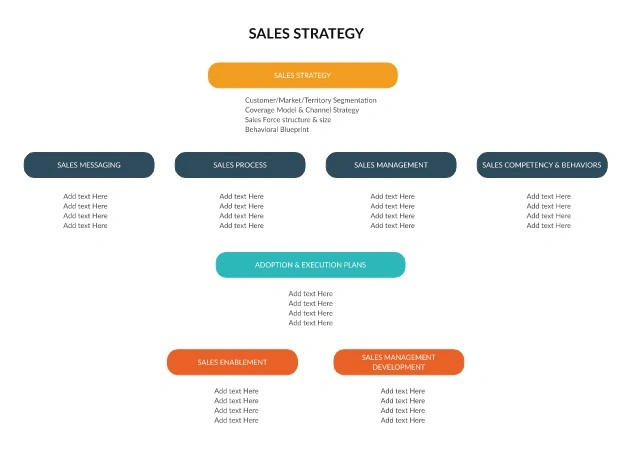
Image Source
If you're more of a visual person, creating a diagram for your sales strategy can be helpful. Use Creately to create an attractive sales strategy to share with your team.
We like this template because it allows you to map out the key elements of your strategy by breaking action items and values down by category.
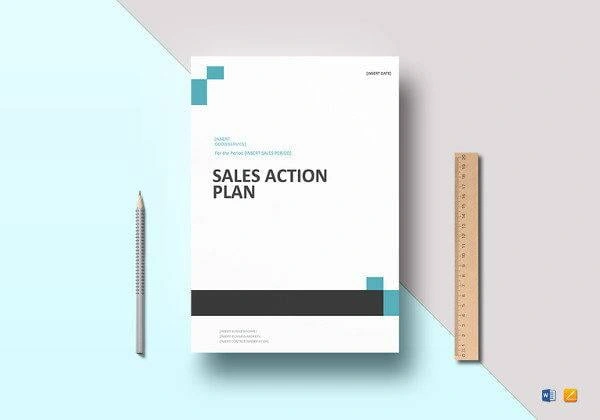
Image Source
Dive into the details of your sales strategy with a sales action plan. It has a minimalistic but super clean layout.
This sales action plan is effective because it focuses on the more concrete elements of achieving your sales goals, such as positioning and strategic plays. It is eight pages long and fully customizable in either Word or Pages.
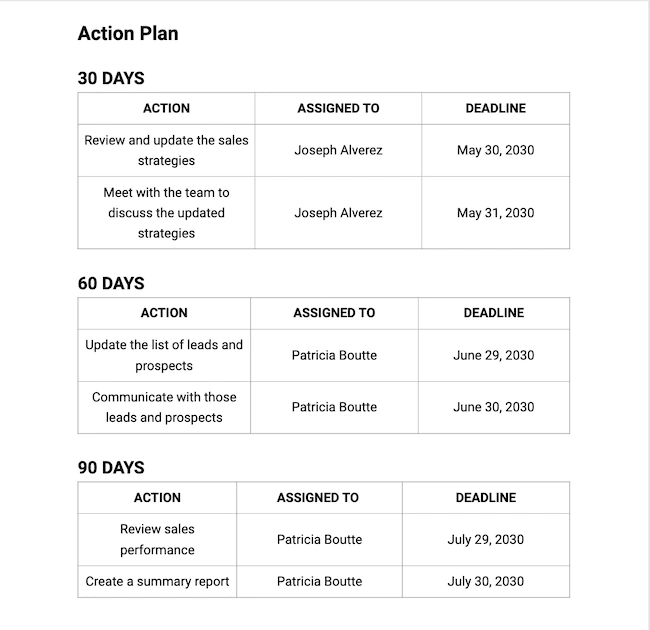
Image Source
We love 30-60-90 day plans because they allow you to set a realistic pace for accomplishing your goals, whether they are short- or long-term.
This sales plan does some of the work for you by outlining tasks related to your sales goals. You can check off boxes as you complete each item to ensure you're creating a sound sales strategy.
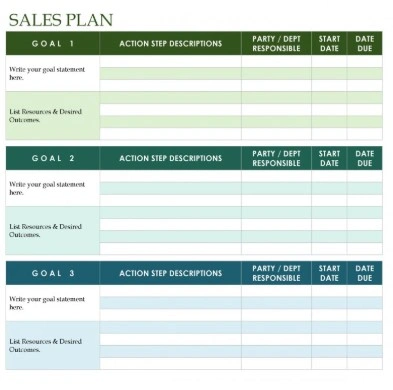
Image Source
This template breaks down goals into action items, helps you think about how to assign responsibilities, and gets you to commit to specific dates.
The best part is that it focuses on multiple goals, giving you a bird's eye view of several initiatives you may be putting together.
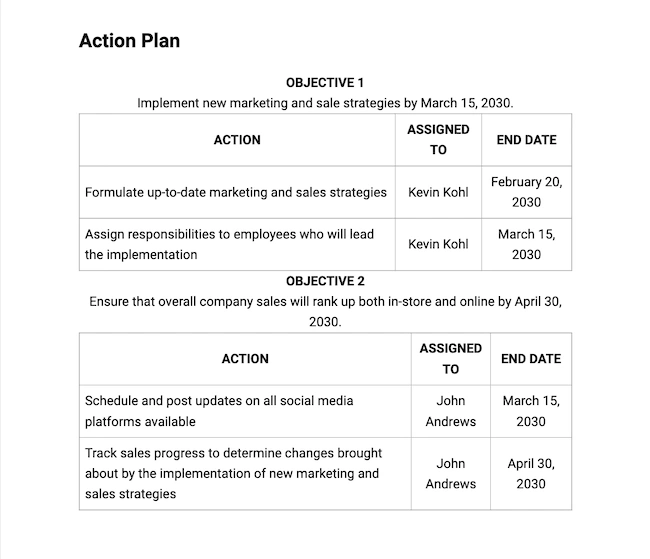
Image Source
Look ahead at your sales strategies for the next 90 days using this sample sales plan. In this document, you'll be able to break your sales plan down into phases, tasks, and key questions for your sales goals. The final section is a mind map for your sales process and pipeline strategies, which is especially great for brainstorming.
Create a Sales Plan that Grows with Your Business
There‘s no one-size-fits-all sales plan. The only wrong way to use a sales plan is to write it at the start of the year or quarter and never touch it again. You should periodically review and update it as time goes on to ensure you're focused and on track. By continuously improving on your plan, you can ensure your company generates revenue more effectively than it ever did in the past.
Editor's note: This post was originally published in December 2019 and has been updated for comprehensiveness.















































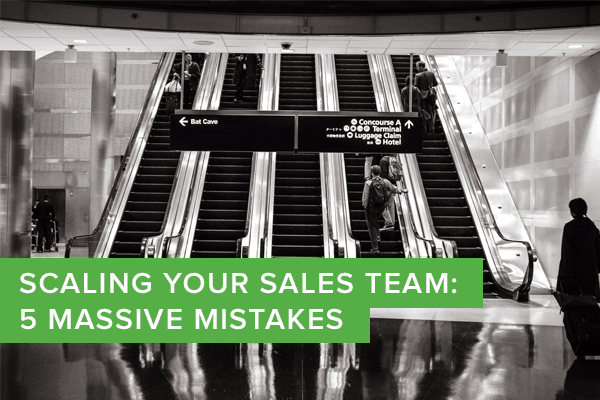









 the company’s response. The purpose of a risk management strategy is to mitigate risks that are a threat, accept those that are within the company’s risk tolerance, and adapt when the risks jeopardize the company’s goals.
the company’s response. The purpose of a risk management strategy is to mitigate risks that are a threat, accept those that are within the company’s risk tolerance, and adapt when the risks jeopardize the company’s goals. leverage both the
leverage both the  With all factors held constant (environment, product/service offerings, corporate business models, industry, etc.) the corporation with a healthy attitude towards risk is more likely to leverage opportunities for innovation. But the health attitude is not enough. The ability to learn, adapt, leverage, and grow will decide which corporation is able to innovate, and thus better realize its goals.
With all factors held constant (environment, product/service offerings, corporate business models, industry, etc.) the corporation with a healthy attitude towards risk is more likely to leverage opportunities for innovation. But the health attitude is not enough. The ability to learn, adapt, leverage, and grow will decide which corporation is able to innovate, and thus better realize its goals. For many companies, success is a changing metric that fluctuates with project performance. A reduction in scope, change in requirements, or extension of the schedule as a result of poorly managed (or leveraged) risk should not correspond with a changing definition of success.
For many companies, success is a changing metric that fluctuates with project performance. A reduction in scope, change in requirements, or extension of the schedule as a result of poorly managed (or leveraged) risk should not correspond with a changing definition of success.






 No matter your political persuasion, I think we can agree that recent events are contributing to increasing degrees of uncertainty and distraction for almost everyone.
No matter your political persuasion, I think we can agree that recent events are contributing to increasing degrees of uncertainty and distraction for almost everyone.
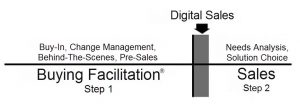

 Thanks to
Thanks to 
 Thanks to
Thanks to 






